The Western Digital Black PCIe SSD (512GB) Review
by Billy Tallis on March 8, 2017 8:30 AM ESTSequential Read Performance
The sequential read test requests 128kB blocks and tests queue depths ranging from 1 to 32. The queue depth is doubled every three minutes, for a total test duration of 18 minutes. The test spans the entire drive, and the drive is filled before the test begins. The primary score we report is an average of performances at queue depths 1, 2 and 4, as client usage typically consists mostly of low queue depth operations.
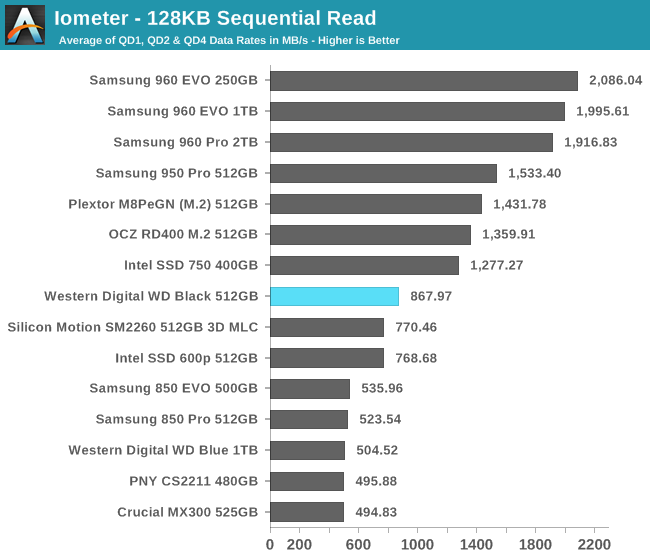
The sequential read speed of the WD Black beats the Silicon Motion SM2260 drives (both MLC and TLC), but the WD Black is otherwise way behind the rest of the PCIe SSDs.
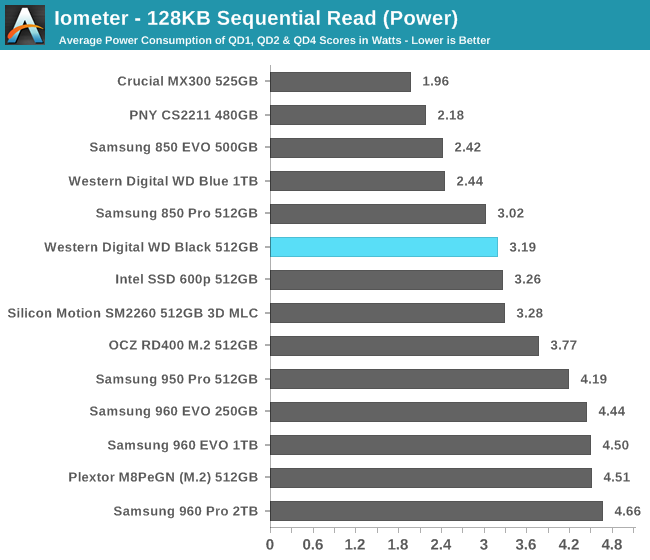
The WD Black has lower power draw than any other PCIe SSD during the sequential read test, and its efficiency is better than almost all other TLC drives (SATA or PCIe). However, the WD Black's efficiency is still about 60% worse than the Samsung 960 EVO.
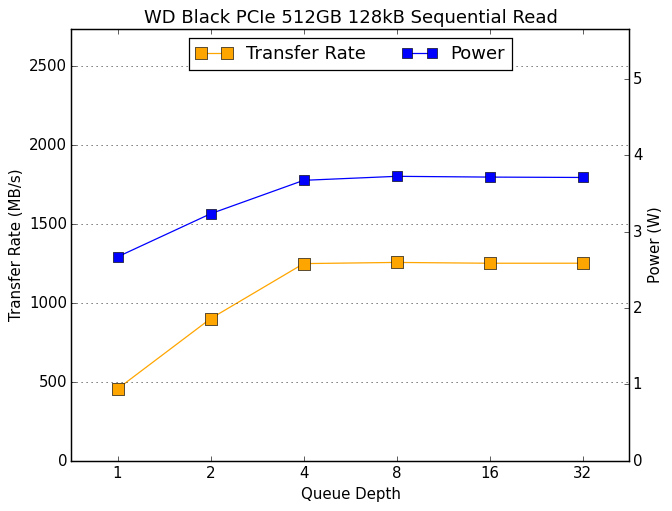 |
|||||||||
At QD 1 the WD Black is performing close to the limit of SATA, and it saturates by QD4 at almost 1.3GB/s. Power consumption never quite reaches 4W, so thermal throttling is very unlikely.
Sequential Write Performance
The sequential write test writes 128kB blocks and tests queue depths ranging from 1 to 32. The queue depth is doubled every three minutes, for a total test duration of 18 minutes. The test spans the entire drive, and the drive is filled before the test begins. The primary score we report is an average of performances at queue depths 1, 2 and 4, as client usage typically consists mostly of low queue depth operations.
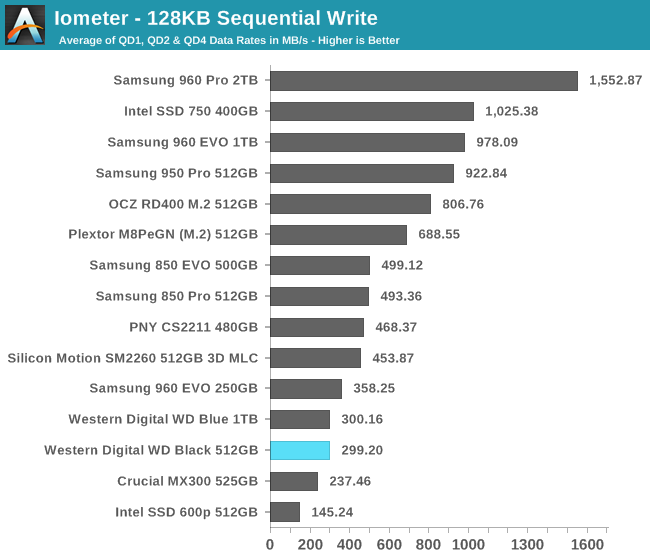
The sequential write speed of the WD Black is tied with the WD Blue and outperforms only the drives using IMFT 3D TLC. The Samsung 960 EVO and all of the MLC SSDs in this comparison sustain much better sequential write performance.

The WD Black's power consumption during the sequential write test is on par with other PCIe SSDs, giving it a typical efficiency for planar TLC SSDs. The WD Black is more efficient than the Intel 600p but loses quite badly to the other 3D TLC drives.
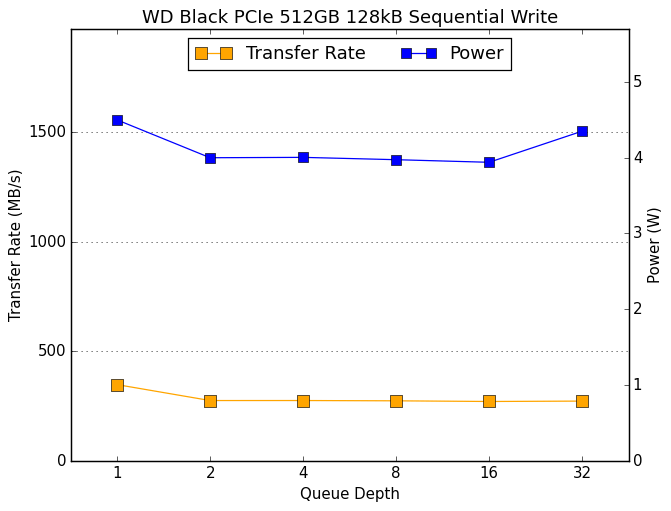 |
|||||||||
The WD Black hits steady state during the first phase of the test and power and performance remain the same for the rest of the test, except that power consumption jumps up a bit at the very end. At no point during this test does the WD Black's sequential write speed exceed what SATA SSDs are capable of.










36 Comments
View All Comments
dgingeri - Wednesday, March 8, 2017 - link
At least they priced it about right. It's more expensive than the Intel 600p, but far less expensive than the 960 EVO and slightly less expensive than the M8Pe. This part of the market is odd. Usually, the fastest performing parts are FAR more expensive for just a small return on performance. In SSDs right now, the differences in price are fairly small, but the differences in performance are huge. I think the 960 EVO is about the best deal for a SSD, and this thing is just a shame to the "Black" label.Guspaz - Wednesday, March 8, 2017 - link
So, the product called "WD Black" is coloured blue, but there is also a "WD Blue" product? Let me guess, that one has a black PCB?Gasaraki88 - Wednesday, March 8, 2017 - link
Nope, it would have made sense if they spent the money to use a black pcb for the black drive, a blue pcb for the blue drive and the green pcb for the green drive. Nope.This drive gives the "Black" label a bad name anyway.
MrSpadge - Wednesday, March 8, 2017 - link
They probably thought "our Black HDDs are really slow nowadays, with all those budget SSDs around, so let's call a barely-not-too-slow SSD: BLACK".madspartus - Wednesday, March 8, 2017 - link
WD Black: planar 15 nm TLC NANDI'll be sure to remember that WD doesn't give a shit about the quality and performance of their products and branding. Way to dilute the brand, hope the short term gains are worth it.
shabby - Wednesday, March 8, 2017 - link
The branding is fine, the wd green ssd will be a qlc nand drive.bug77 - Thursday, March 9, 2017 - link
True, black has always been the performance line, it shouldn't go on any TLC parts. Not even on 3D TLC.romrunning - Wednesday, March 8, 2017 - link
On your Storage Bench - Light (Latency) graph, you show the Intel 750 and Patriot Hellfire on top despite the Samsung drives beating them both in "Full" condition. So if they tie on the empty drive score, the Samsungs should be on top due to their full drive latency.Gasaraki88 - Wednesday, March 8, 2017 - link
How come you didn't test any drives that use the Phison E7 controllers? Patriot Hellfire, MyDigitalSSD BPX, and Corsair Force?BrokenCrayons - Wednesday, March 8, 2017 - link
This certainly isn't an impressive product.